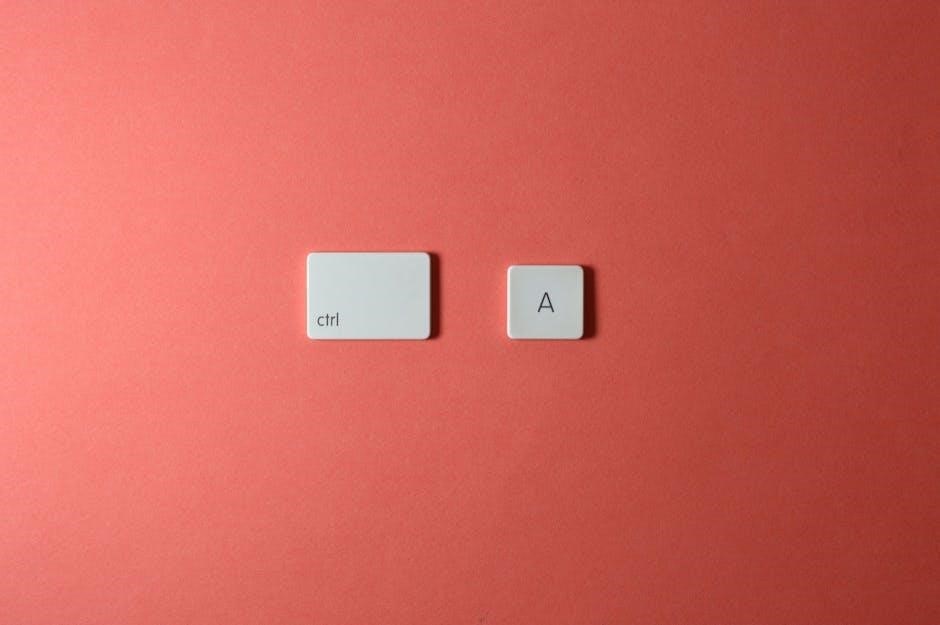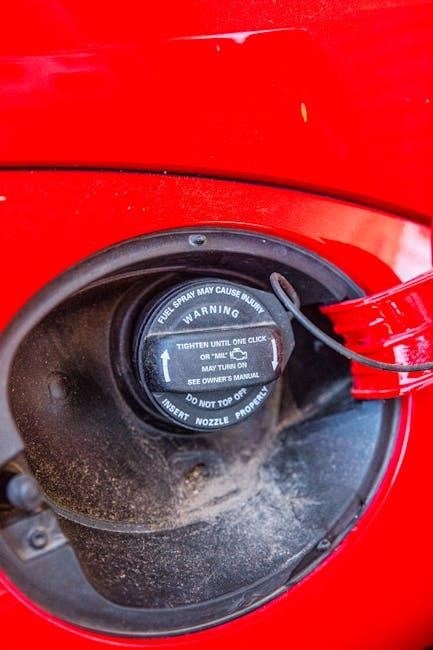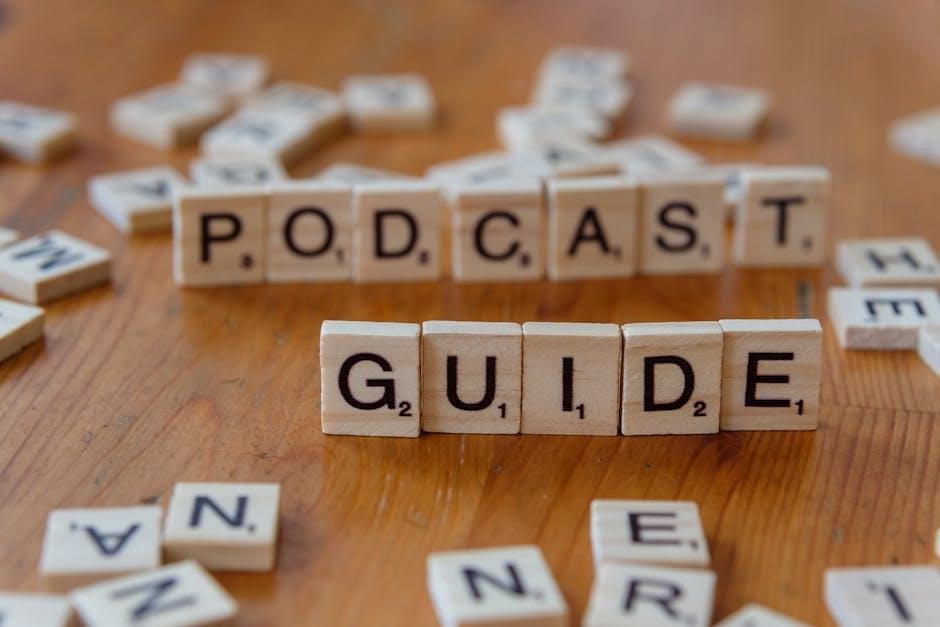
-
By:
- elizabeth
- No comment
wii u instruction manual
Welcome to the official Wii U Instruction Manual. This guide provides essential information for setting up, operating, and troubleshooting your console. It ensures optimal performance and safety.
Key Features of the Wii U Console
The Wii U console offers stunning high-definition gaming with support for 1080p, 1080i, 720p, 480p, and 480i resolutions. It features the innovative Wii U GamePad, which includes a 6.2-inch touchscreen, motion controls, and a built-in microphone. The console comes with 8 GB or 32 GB of internal storage, expandable via external USB drives. It supports backward compatibility with Wii games and accessories, ensuring a seamless transition. Additional features include Nintendo TVii for media integration and a robust online platform for downloading games and content.
Why Read the Manual?
Reading the Wii U Instruction Manual is crucial for understanding proper setup, safety precautions, and optimal use of your console. It provides detailed guidance on configuring parental controls, troubleshooting common issues, and maintaining your system. The manual also explains how to use the Wii U GamePad, access online features, and ensure compliance with safety standards. By following the instructions, you can enhance your gaming experience, prevent potential damage, and stay informed about software updates and security measures.
Nintendo’s Update Policy for Wii U
Nintendo regularly releases system updates for the Wii U to improve performance, enhance security, and add new features. These updates are automatically applied to ensure your console operates at its best. The manual recommends checking the official Nintendo support website for the latest updates and guidelines. Regular updates are essential for maintaining optimal functionality, protecting your data, and accessing all console features. Always follow the provided instructions to keep your Wii U up to date.

Hardware Components of the Wii U
The Wii U Console includes the main unit, Wii U GamePad, and accessories like the AC adapter and HDMI cable. Additional peripherals enhance gameplay and connectivity.
Wii U Console Overview
The Wii U Console is a versatile gaming system supporting high-definition video modes like 1080p, 1080i, 720p, 480p, and 480i. It features 2048 MB of DDR3 memory and 8 GB of internal flash storage. The console is compatible with both Wii U and Wii Game Discs, offering backward compatibility. Equipped with HDMI and USB ports, it ensures seamless connectivity for enhanced gaming experiences. Its compact design integrates powerful hardware, making it a central hub for entertainment and gameplay.
Wii U GamePad Details
The Wii U GamePad is an innovative controller featuring a 6.2-inch touchscreen display. It combines traditional controls with intuitive touch-based gameplay, offering a unique gaming experience. The GamePad includes motion controls, a front-facing camera, and a microphone. Its battery life supports extended play sessions, and it charges via USB. Designed for comfort, the GamePad enhances both local multiplayer and off-TV gameplay, making it a central accessory for the Wii U console. Regular maintenance ensures optimal performance and longevity.
Accessories and Peripherals
Explore a variety of Wii U accessories designed to enhance your gaming experience. The Wii U Pro Controller offers a traditional gaming feel, while additional Wii Remotes and Nunchuks support multiplayer fun. The Wii U Sensor Bar improves motion controls, and HDMI cables ensure high-definition visuals. Optional peripherals like charging stations and screen protectors maintain your setup. These accessories are crafted to complement the console and GamePad, ensuring seamless gameplay and versatility for all players.
Safety Precautions
Handle the Wii U console and accessories with care to avoid damage. Ensure proper ventilation to prevent overheating. Keep cables organized to reduce tripping hazards and electrical risks.
Handling the Console
Handle the Wii U console with care to prevent damage. Avoid exposure to liquids, extreme temperatures, or physical stress. Clean the console with a soft cloth and store it upright in a well-ventilated area to ensure proper cooling and longevity.
Power Supply and Cables
Use only the official Nintendo AC adapter for the Wii U console to ensure safe operation. Avoid overloading power outlets or using damaged cables, as this may cause electrical issues. Keep the console in a well-ventilated area to prevent overheating. Regularly inspect power cords for signs of wear and tear. Never submerge cables in water or expose them to extreme temperatures. Properly manage cables to avoid tripping hazards and maintain a stable power connection for optimal performance.
Storage and Environmental Conditions
Store the Wii U console and accessories in a cool, dry place away from direct sunlight. Avoid exposure to extreme temperatures, humidity, or moisture. Ensure the console is placed on a stable, flat surface. Keep it away from heating vents or radiators. Proper storage and environmental conditions help maintain performance and prevent damage. Ideal operating temperatures are between 50°F and 90°F (10°C and 32°C). Avoid placing the console in enclosed spaces without ventilation to prevent overheating and ensure reliable operation.

Initial Setup and Configuration
This section guides you through unboxing, connecting your Wii U to a TV, and completing the first-time setup process. Follow on-screen instructions carefully for a smooth start.
Unboxing and Preparation
Carefully open the Wii U box and ensure all components are included. Check for the console, GamePad, power cables, and HDMI cable. Read the safety guidelines to avoid damage. Place the console on a flat, stable surface in a well-ventilated area. Connect the power cord securely and ensure proper ventilation; Prepare the GamePad by charging it using the provided cable. Familiarize yourself with all accessories before proceeding to setup.
Connecting the Console to a TV
Locate the HDMI port on both the Wii U console and your TV. Insert one end of the HDMI cable into the console’s HDMI output and the other into the TV’s HDMI input. Turn on the console and TV, then select the correct HDMI input on your TV. Ensure the TV is set to the proper input channel. If needed, adjust the display settings in the Wii U menu to match your TV’s resolution. Verify the connection by checking for a clear image on the screen. If issues arise, check cable connections and settings.
First-Time Boot and Initial Setup
Power on the Wii U console and follow the on-screen instructions. Select your preferred language, country, and time zone. Choose your TV’s display format and connect to a network for online features. Accept the terms of use and download any available system updates. Create or select a user account and set up parental controls if desired. Once complete, the Wii U Menu will appear, allowing access to games, apps, and settings.
Navigating the Wii U User Interface
The Wii U Menu is your gateway to games, apps, and settings. Use the GamePad to scroll through icons, launch software, and access system features seamlessly.
Wii U Menu Overview
The Wii U Menu is the central hub for accessing games, apps, and system settings. Use the GamePad to navigate through icons, launch software, and organize content. The Home Menu provides quick access to recently played games and downloaded apps. Features like folders allow easy organization of your games and content. The menu is designed for intuitive navigation, ensuring a smooth user experience. Regular updates may add new features or improve functionality, enhancing your Wii U experience over time.
Home Menu and Quick Access
The Home Menu offers quick access to your favorite games and apps, streamlining your gaming experience. Use the GamePad to navigate and launch content effortlessly. Icons represent installed games and apps, while the Favorites section allows you to pin frequently used items. Recent downloads and updates are highlighted for easy access. Notifications and system updates are also displayed here, ensuring you stay informed. Customize the layout by organizing icons into folders for a personalized experience, making navigation even more convenient and efficient.
Settings Menu and Customization
Access the Settings Menu to customize your Wii U experience. Navigate through categories like Display, Sound, and Controllers to tailor settings to your preferences. Adjust screen brightness, audio output, and controller sensitivity for optimal comfort. Parental Controls allow you to restrict content and set usage limits. Manage user accounts and system updates within this menu. Regularly check for updates to ensure your console runs smoothly and securely. Customize your experience to enhance gameplay and convenience, ensuring a personalized and enjoyable experience for all users.

Using the Wii U GamePad
The Wii U GamePad combines a 6.2-inch HD display with motion controls for immersive gaming. Use the touchscreen for intuitive navigation and gameplay. Charge regularly for optimal performance;
GamePad Controls and Layout
The Wii U GamePad features a 6.2-inch touchscreen display, analog sticks, and a D-pad for precise control. The layout includes A, B, and X, Y buttons, as well as L and R shoulder buttons for gaming. The Start, Select, and Home buttons provide quick access to menus. The GamePad also includes motion sensors and a gyroscope for enhanced gameplay. Its ergonomic design ensures comfort during extended play sessions. Use the rear triggers and Z buttons for additional functions in supported games.
Using the Touchscreen
The Wii U GamePad’s touchscreen offers intuitive navigation and gameplay control. Tap, swipe, or pinch to interact with on-screen elements. For precise actions, use the stylus or your finger. The touchscreen is responsive and supports multi-touch gestures. Access the Home Menu, adjust settings, or view game maps directly. Ensure the screen is clean for optimal performance. Regularly calibrate the touchscreen via the Settings menu for accuracy. Use the touchscreen to enhance your gaming experience with innovative controls and quick access to features.
Charging and Maintaining the GamePad
Charge the Wii U GamePad using the included USB cable or cradle. A full charge takes approximately 2.5-3 hours, providing up to 3-5 hours of gameplay. Avoid overcharging to preserve battery health. Clean the touchscreen with a soft cloth and avoid harsh chemicals. Regularly update the GamePad software via the Wii U Menu for optimal performance. Store the GamePad in a cool, dry place when not in use. Calibrate the touchscreen periodically for accuracy.

Managing Games and Content
Easily manage your Wii U games and content by organizing them in folders, accessing the Nintendo eShop, and using external storage for expanded capacity.
Downloading Games from the Nintendo eShop
The Nintendo eShop is your go-to destination for downloading Wii U games. To purchase games, add funds using a credit card or Nintendo eShop Card. Browse through various categories, including new releases, indie titles, and classic games. Once purchased, games are automatically downloaded and added to your library. You can organize them in folders for easy access. Ensure your console is connected to the internet and has sufficient storage before downloading. Parental controls can restrict purchases if enabled.
Managing Downloaded Games
Once games are downloaded, they appear in the Wii U Menu. Organize games by creating folders for easy access. To manage storage, check the available space in System Settings. You can delete games to free up space, then redownload them later from the Nintendo eShop. Purchased games are tied to your Nintendo account, ensuring access across devices. Regularly update games to enjoy the latest features and improvements, and use parental controls to restrict access to certain content.
Updating Games and Software
Regular updates are essential for optimal performance. To update games and software, visit the Nintendo eShop or select the game icon in the Wii U Menu and choose “Update.” Automatic updates can be enabled in System Settings. Ensure your console is connected to the internet during updates. Updates improve gameplay, fix bugs, and add new features. Always install the latest versions to maintain compatibility and security. This ensures your Wii U experience remains smooth and up-to-date.

Parental Controls
Parental Controls help restrict access to certain features and content. Set a PIN to limit online purchases, gameplay, and user profiles. Customize settings to suit your family’s needs.
Setting Up Parental Controls
To set up Parental Controls on the Wii U, navigate to the Settings menu and select Parental Controls. Choose your desired restrictions, such as limiting access to games based on their rating or blocking online features. Create a PIN to secure these settings. You can also manage user profiles and restrict purchases from the Nintendo eShop. Follow the on-screen instructions to customize these options and ensure a safe gaming environment for all users.
Restricting Access to Content
The Wii U allows you to restrict access to content using Parental Controls. You can customize settings to limit games based on their ESRB rating, block online features, and restrict purchases from the Nintendo eShop. Set a PIN to secure these settings and prevent unauthorized changes. This feature helps ensure a safe and appropriate gaming environment for all users, aligning with your preferences and requirements.

Connecting to the Internet
Connect your Wii U to the internet via a wired or wireless network. Configure settings in the System Settings menu to access online features, updates, and gaming.
Setting Up a Network Connection
To connect your Wii U to the internet, access the System Settings menu. Select Internet and choose your network from the list. Enter your Wi-Fi password when prompted. For a wired connection, use an Ethernet cable. Ensure your router is nearby for optimal signal strength. If prompted, update your console to ensure compatibility. Troubleshooting tips are available in the manual. Once connected, you can access the Nintendo eShop, online gaming, and system updates. Refer to the Wii U Menu for additional network settings.
Troubleshooting Internet Issues
If you experience internet issues with your Wii U, restart your router and console. Ensure your network password is correct and check for system updates. Verify your network settings in the System Settings menu. If problems persist, test with a wired connection or move the console closer to the router. For further assistance, visit Nintendo’s official support website or refer to the Wii U manual for detailed troubleshooting guides.

Maintaining Your Wii U Console
Regularly clean vents and accessories to prevent dust buildup. Update system software for optimal performance. Store the console in a cool, dry environment to ensure longevity and functionality.
Regular Maintenance Tips
Keep your Wii U console in top condition by cleaning vents and accessories regularly. Use a soft cloth to wipe dust from surfaces and avoid liquids. Store the console upright in a well-ventilated area, away from direct sunlight and moisture. Ensure proper cooling by maintaining space around the console. Avoid extreme temperatures and humidity to prevent damage. Regularly check for system updates to maintain performance and security. For optimal functionality, follow these care guidelines to extend the life of your Wii U system.
Updating System Software
Regularly updating your Wii U system software ensures optimal performance, security, and access to new features. To update, connect the console to the internet and navigate to the System Settings menu. Select “System Update” to check for and install the latest version. Automatic updates are enabled by default, but manual checks are recommended for the most recent improvements. Always follow on-screen instructions and avoid interrupting the update process to prevent system issues. Keeping your Wii U updated ensures a smooth gaming experience.
Cleaning the Console and Accessories
To maintain your Wii U console and accessories, use a soft, dry cloth to wipe away dust and smudges. For tougher marks, lightly dampen the cloth with water, but avoid liquids contacting electrical components. The GamePad’s touchscreen can be cleaned with a screen-specific cleaner and a microfiber cloth. Gently wipe in one direction, avoiding pressure. Regular cleaning prevents dust buildup and ensures optimal performance. Always unplug the console before cleaning to avoid damage.

Troubleshooting Common Issues
Identify and resolve common problems by checking connections, restarting the console, or updating software. Visit Nintendo Support for detailed solutions and assistance.
Identifying and Solving Common Problems
Common issues with the Wii U include connection problems, game freezes, and error messages. Start by checking all cables and restarting the console. For persistent issues, visit Nintendo Support for troubleshooting guides. Refer to the manual for step-by-step solutions. If problems persist, contact Nintendo support or check online forums for community advice. Regular updates and proper maintenance can prevent many issues.
Resetting the Console
Resetting your Wii U console can resolve software issues. A soft reset involves returning to the Home Menu, while a hard reset requires pressing and holding the Power button for 10 seconds. Note that a hard reset will not delete saved data but should be used sparingly; For system restores, select “Restore Factory Settings” in the Settings menu. Always back up important data before performing a factory reset to avoid loss of saved games and custom settings.

Additional Resources
Explore official Nintendo support for comprehensive guides, troubleshooting, and updates. Visit online forums for community tips and discussions. Third-party repair guides offer detailed DIY maintenance instructions.
Official Nintendo Support
For comprehensive assistance, visit Nintendo’s official support website. Access detailed guides, troubleshooting, and software updates. The site offers PDF manuals, warranty info, and contact options for customer service. Additionally, Nintendo provides regional support pages for localized assistance. If you encounter issues, the support team is available to address concerns. Ensure to check for the latest manual versions, as updates may occur. This resource is your go-to for reliable, official information to enhance your Wii U experience.
Online Communities and Forums
Engage with online communities and forums dedicated to Wii U users. These platforms offer tips, troubleshooting advice, and shared experiences. YouTube channels provide step-by-step tutorials and product overviews. Forums allow users to discuss issues, share solutions, and stay updated on the latest developments. Participating in these communities can enhance your Wii U experience and provide additional support beyond the official manual. Active engagement helps you stay informed and connected with fellow gamers and technical experts.
Third-Party Repair Guides
Third-party repair guides offer detailed instructions for DIY repairs and modifications. These resources often include step-by-step tutorials for replacing components like Joy-Con buttons or the motherboard. Some guides also cover advanced modifications, such as softmodding for homebrew applications. While these guides can be helpful, ensure they are from reputable sources. Be aware that modifying your console may void its warranty or cause system instability. Proceed with caution and verify the credibility of the source before attempting any repairs or modifications.